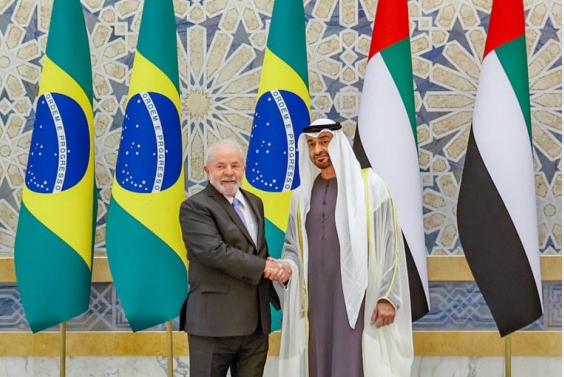
The announcement in late August 2023 that Saudi Arabia and the United Arab Emirates were among the six nations joining an expanded Brazil, Russia, India, China, and South Africa (BRICS) grouping draws renewed attention to the Emirates’ engagement in South America through bilateral and multilateral channels.
BRICS is important to these Arab Gulf States as they seek to balance their relations between West and East and join groupings that serve multiple purposes including supporting relations with key states such as India and China, which are and will increasingly be, key energy markets, leveraging contacts to build consensus on major policy issues including in the United Nations, and in the case of the UAE, building towards other economic opportunities such as a Comprehensive Economic Partnership Agreement (CEPA) with MERCOSUL (the southern common market).
The move to join BRICS follows on from the UAE having joined the New Development Bank (NDB) in September 2021. The NDB was established by the BRICS states in 2014. This was a particularly attractive proposition since the bank represents, in the view of the Executive Council in Abu Dhabi, a fairer system of governance than Western-dominated multilateral development banks such as the IMF or World Bank.
However, Emirati efforts to expand relations vis-à-vis Brazil and South America can be traced back more broadly to 2005 when Brazilian President Luiz Inacio Lula da Silva created the Summit of South American - Arab Countries (ASPA). Whilst the Lula government’s position on Iran and Palestine didn’t mesh well with many of the Gulf Cooperation Council (GCC) states, perhaps impacting the number of heads of state who attended the first summit in Brasilia, the forum helped to boost the number of new Gulf embassies opening across South America from 2007 to 2010. Subsequently, more heads of government met in Qatar in 2009, Peru in 2012, and Saudi Arabia in 2015.
UAE – South American trade almost tripled from $11 billion in 2008 to $30 billion in 2012 with economic cooperation remaining a key driver. Brazil remains the UAE’s leading trading partner in the region, accounting for $4 billion in 2022. In second place is Mexico, whose trade with the UAE totaled $2.1 billion in 2022 and has proven to be an important manufacturing base for the U.S. and Canada as well as shown its willingness to conclude a number of free trade deals, an area which is vital to the UAE advancing its competitive position in the region. The UAE accounted for 77 percent of GCC investments in South America from 2016 to 2021, which although at a relatively low $4 billion, still highlights how the country has stolen a march on other GCC states in terms of GCC trade with the region.
UAE interests in the region include energy, food production, tourism, infrastructure, and housing. Given the size of South America’s status as a leading global exporter of soybeans and meat products, the tie-up could be considered highly complementary. Top UAE investment company Mubadala has had a mixed experience through its investments in Brazil, but ultimately won a controlling stake in Sudeste Port in Rio state for the export of iron ore. DP World is present at Port Santos as part of its global strategy aimed at enhancing and benefitting from international trade flows. The UAE buttressed commercial activities with public diplomacy and was quick to roll out post-COVID recovery and humanitarian assistance activities through bilateral and multilateral channels such as the Organization of American States. Dubai continues to play an important convening role by hosting the Global Business Forum Latin America.
Relations between the UAE and Brazil took an unexpected turn under the Jair Bolsonaro presidency when political and personal ties converged more fully. Bolsonaro’s government was very much aligned with the policies of the Donald Trump administration in the U.S. as well as Israeli and Arab Gulf allies, in support of the isolation of Iran, containment of Hezbollah, and the expansion of trade and military ties. In 2019, the first year of his presidency, Bolsonaro visited the UAE and signed 8 agreements in areas such as data protection, strategic relations, artificial intelligence, defense, business, and biodiversity conservation. Given the re-election of President Lula in January 2023, inheriting a country affected by inflation and the pandemic, the country is likely to turn again to the Gulf with the expectation that some of its economic challenges can be addressed by attracting greater trade and financing from the GCC states.
Whilst the economic aspects have been developing, the UAE is also interested in broadening its traditional dependence on Western security partners. From sending Colombian mercenaries to fight in Yemen in 2015 to importing bombs from Colombia for use against the Islamic state, and potentially other regional adversaries, the UAE is taking further steps. For example, Brazilian strategic defense company Novaer has signed a contract with the UAE to provide 24 combat aircraft to be constructed in Al Ain. In August 2023, the Brazilian Air Force’s Department of Aerospace Science and Technology (DCTA) planned to develop an unmanned and autonomous system, smart weapons, and air and space projects with the UAE conglomerate, the EDGE Group. The consequences of these deals are potentially more far-reaching than simply plugging manpower gaps or arms supplies because these are strategic moves designed to help boost the long-term military–industrial capabilities of the UAE.
Elsewhere in the region, the UAE continues to engage key strategic partners such as Argentina, Paraguay, and Uruguay with an emphasis on concluding a Comprehensive Economic Partnership Agreement (CEPA) with MERCOSUL in the near term. Whilst Brazil is the current president of the MERCOSUL grouping, Paraguay will assume the presidency in the first half of 2024. Given the speed at which CEPAs have been concluded with other states, it is possible one could be rolled out with a sub-region that shares UAE interests in economic development and growth. Even for states such as Venezuela, normally aligned with Iran in what analysts in the U.S. have dubbed an “axis of annoyance,” the UAE is still able to engage on more narrow terms to ensure Venezuela’s oil and gas industry is made more efficient. In the process, the UAE has become a major international intermediary for oil re-exports, boosting its weight in international oil markets and OPEC+, and possibly in gold as well.
Whilst the UAE's imperative to boost military supplies may have diminished somewhat since its military withdrawal from Yemen in 2020, it is clear that South American defense companies will continue to play an important role in boosting UAE military capacity. Food security is also bound to remain high on the agenda over the coming years, along with finding more manufacturing investments or joint ventures in Mexico. Rebalancing at the multilateral level, through BRICS and potentially through MERCOSUL, shows an inherent resolve to boost trade and investment as part of its vision for a post-oil future. Whilst its early market entry and close political coordination show both resolve and sustainability, a key question is whether further Gulf state entrants or changes in political leadership might constrain this rapid growth. Qatar, for example, is already making headway in signing economic agreements with Brazil and other South American states, loaned Argentina $775 million to settle an IMF payment, and offers itself as a neutral intermediary in U.S. - Venezuela negotiations. Therefore, it too has positioned itself to gain in Venezuela’s energy sector.
* Robert Mason is a non-resident fellow with the Gulf Research Center

